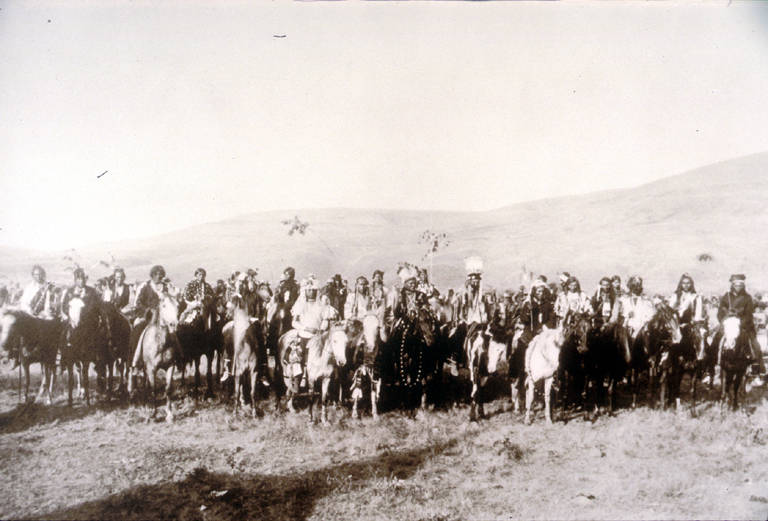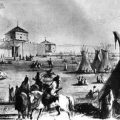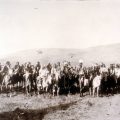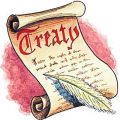
Under the Constitution, Indian tribes are seen as sovereign nations and thus the United States negotiated treaties with Indian tribes. These are not treaties which ended wars, but rather they are agreements concerning peace, and, most frequently, the sale of Indian lands to the United States. In the treaty process, the United States usually ignored traditional tribal concepts of government in order to install puppet dictatorships. In addition, the United States often misrepresented, or misinterpreted, the treaties with deadly consequences for both the tribes and the American settlers. One example of this can be seen in the 1863 treaty with the Nez Perce which laid the foundation for the 1877 Nez Perce War.
The purpose of the treaty was ostensibly to protect the Nez Perce from illegal non-Indian settlement in their territory. In order to protect them, the size of their territory was reduced. The treaty was signed by 51 Nez Perce men, giving it the appearance of Nez Perce support, but the only ones who signed were U.S. government-supported chiefs and sub-chiefs.
Background:
Prior to the arrival of the Europeans, there was no Nez Perce tribe with regard to a unifying political or government organization. While the bands shared the same language and culture, there was no integration of the various Nez Perce bands into a larger government structure. The Nez Perce tribe was composed of a number of political autonomous bands, each with its own chiefs and council. There were two ways of obtaining chiefly status at the band level. The first was to gain a reputation as being a generous man by sponsoring feasts and tutelary spirit dances and by distributing goods. The second way was through war exploits. To become a war chief, a warrior had to obtain ten war honors (coups).
Unlike a European king, the Nez Perce chief had no coercive powers. The chief’s duties were to arbitrate disputes, act as spokesman, oversee the well-being of the villagers, and provide an example of outstanding and generous conduct, sharing his wealth with the needy. In return, the people often gave him food, clothing, and other goods, especially for settling arguments.
At times, neighboring Nez Perce bands would be unified into confederacies or composite bands. These composite bands had no single head chief or permanent council.
The 1855 Treaty:
In 1855, the United States government, represented by Governor Isaac Stevens, met with a number of tribes, including the Nez Perce, at Walla Walla, Washington. All of the tribes attending the council understand that the government wants to force the tribes to choose a reservation to prevent wars and to stay out of the way of settlers who want to claim Indian land.
Stevens told the Indian leaders that there were some “bad” Americans who made trouble for the Indians, but east of the mountains the Great Father had taken measures to help his “Indian children” by moving them across a great river where they were away from the “bad” Americans. He carefully omitted any mention of the coercion, starvation, death, and misery that accompanied the Trail of Tears.
Nez Perce leader Lawyer told his people that the agreement with the Americans would protect their villages from the Americans and that without it, the Americans would simply take their lands. Joseph, the leader of the Wallamawatkin band, pleaded with the Americans to include his peoples’ Wallowa valley in Oregon as a part the Nez Perce reservation. Joseph did not sign the treaty, but the United States maintained the legal fiction that the Nez Perce bands were a single, unified tribe under the leadership of Lawyer and that Lawyer represented all of the Nez Perce.
Lawyer, a practicing Christian, was selected by the United States as the Head Chief of the Nez Perce. From the Nez Perce perspective, he was not a chief, but a tobacco cutter-a sort of undersecretary for Looking Glass, Eagle of the Light, Joseph, and Red Owl. As a chief selected by the United States, Lawyer received certain economic considerations from the government. The Nez Perce felt that Lawyer had no authority.
The 1855 treaty with the Nez Perce was not ratified by the Senate and signed by the President until 1859. At this time, without consulting the Nez Perce, the size of their reservation was reduced from 13,204,000 acres to 7,787,000 acres.
By 1859, the Nez Perce were clearly not a single tribe. About two-thirds of the Nez Perce followed Lawyer and relied upon the laws which had been imposed on them by the American missionaries, soldiers, and Indian agents. On the other hand, several Nez Perce bands saw hypocrisy in the laws and felt that they worked primarily for the benefit of the Americans. These bands maintained their traditional religions and viewed Christianity as the carrier of unjust laws. They preferred to have nothing to do with Christianity.
The 1863 Council:
In 1860, a group of ten Americans invaded the Nez Perce Reservation in violation of the treaty and discovered gold. As a result, more than a thousand gold seekers invaded Nez Perce land in direct violation of the 1855 treaty. The superintendent of Indian affairs met with the Indian agent for the Nez Perce Reservation who recommended that the Nez Perce treaty be modified to allow the gold miners to stay. The Americans then met with Lawyer and his followers who agreed to sell the land around Pierce and Oro Fino (in what is now Idaho). In signing the new treaty, Nez Perce leader Lawyer reminded the Americans that the Nez Perce had not yet received any of the funds promised them in the 1855 treaty. The Americans promised to look into the matter and speed up payment.
Less than a month after the signing of the treaty, Lewiston, Idaho was founded in flagrant violation of the treaty.
In 1862, Senator J.W. Nesmith, in a Senate debate regarding appropriations for the Nez Perce in Idaho, said:
“Treaties are written out conveying away millions of acres, not one word of which the Indians understand; and complicated articles involving the most abstruse legal provisions, furnishing subjects for interminable litigation, are fully explained and elucidated by some ignorant half-breed interpreter, who does not know one letter from another, but who acts under the direction of some politician, who desires to win his way to public favor by perpetrating a huge swindle upon those who have neither power or intelligence adequate to their own protection.”
With regard to the Nez Perce, General Benjamin Alvord reported:
“Even now, at the end of seven years, I can find but few evidences of the fulfillment of the treaty. Lawyer has never received but six months of his salary as head chief, and the house with which he was to be provided has but just been commenced. Few of their annuities have ever reached them.”
In 1862, the American government established a new military post, Fort Lapwai, which was intended to force American trespassers off Nez Perce land. However, the military generally supported the American intruders rather than the Indians.
With the passage of the Idaho Territory Organic Act in 1863 there was increased pressure by the American settlers to support the interest of the miners rather than abide by the treaty. As a result, the Americans brought the Nez Perce chiefs together in a treaty council to negotiate a major reduction in the size of the reservation. The American Indian agent addressed the council:
“We come as your friends, to advise with you, and to arrange for the preserving of your rights. As your friends we propose to you to relinquish to the United States a part of your present Reservation, and to take a new Reservation, smaller than the one you now hold. We also propose that on this new Reservation, each man or family shall have a piece of land in their own right [severalty], in their own name, just as the Americans do.”
He also said:
“We intend to act with perfect justice towards you, in the sight of God.”
During the treaty council Nez Perce chief Lawyer talked to the Americans about breaking their earlier treaty. He said:
“You have broken the treaty, not we. When you broke through the treaty, it did not make my heart sad or sore, I only wondered why you did it. Now, I am called on to look upon this proposition of yours after the Americans have broken the treaty so often.”
In the treaty negotiations it became evident to all that there was a rift between the treaty faction lead by Lawyer and several other bands. At the end of the negotiations, Big Thunder made a formal announcement that his people wished no further part in the treaty and declared that the Nez Perce Nation was dissolved. Big Thunder shook hands with Lawyer telling him that they would be friends, but hereafter they would be a distinct people. All of the headmen, including the members of the Lawyer party, formally agreed that Lawyer no longer had the right to regard himself as spokesman or head chief of the anti-treaty bands.
One newspaper, the Daily Union, reported:
“It appears there is a feud between the Lawyer and Big Thunder party. So antagonistic are they that one of Lawyer’s Chiefs said the other day that Big Thunder hated them as bad as the Blackfeet, and this misunderstanding seems to be irreconcilable.”
Another newspaper, the Daily Oregonian, reported it this way:
“There seems to be great animosity between the bands of ‘Lawyer’ and ‘Big Thunder.’ So much that they hate each other as much as they do the Blackfeet, and until this difference is reconciled, the chances of making a successful treaty seem very slim.”
The Washington Statesman in Walla Walla reported:
“Big Thunder and his band have thus far refused to treat, and it is thought they will take no part in the Council. Eagle-from-the-Light and Joseph’s bands are with Big Thunder and had not at last account made their appearance at the Council grounds. There has long been a feud between these bands and that of Lawyer-they never recognizing Lawyer as a Chief.”
One of the popular rumors among non-Indians was that Confederate agents were talking to the Indians and stirring up trouble against the American treaty council. The Bulletin, a San Francisco newspaper, reported:
“It is generally believed here among loyal citizens that some of Jeff Davis’s disciples have been at work among these Indians, endeavoring to poison their minds against the Government of the United States, and thus prevent them from making a treaty for the cession of a portion of their present reservation.”
One of the American participants in the council, Captain George B. Curry, reported:
“Although the treaty goes out to the world as the concurrent agreement of all the tribe, it is in reality nothing more than the agreement of Lawyer and his band, number in the aggregate not a third part of the Nez Perce tribe.”
Only those tribal leaders within the reduced area of the reservation signed the treaty. The tribal leaders outside of this area absolutely and flatly denied and rejected the treaty.
The Wallamwatkin band, led by Joseph, did not attend this treaty council and did not sign this treaty. The homeland for this band was in the Wallowa Valley of Oregon. His son, Chief Joseph would later put it this way:
“In this treaty, Lawyer acted without authority from our band. He had no right to sell the Wallowa (winding water) country. That had always belonged to my father’s own people, and the other bands had never disputed our right to it.”
While the Wallamwatkin felt that the treaty did not affect them, the United States felt that it had acquired title to the Wallowa Valley in Oregon.
Impact:
In spite of the fact that both the minutes of the treaty council and the newspaper reports make it clear that the bands outside of the reservation area did not agree to the treaty, the United States government acts as if it has purchased the land belonging to the non-treaty bands.
A government investigator was sent to investigate the treaty situation with the Nez Perce bands in Oregon in 1875. He reported that the treaty did not apply to them as they had never signed it. He also pointed out that the government had also violated the treaty by allowing settlement in their area. He wrote:
“In my opinion … the non-treaty Nez Perce cannot in law be regarded as bound by the treaty of 1863; and in so far as it attempts to deprive them of a right to occupancy of any land its provisions are null and void. The extinguishment of their title of occupancy contemplated by this treaty is imperfect and incomplete.”
In spite of this report, the Nez Perce lands in Oregon were opened for American settlement. This set the stage for the 1877 Nez Perce War.



Leave a Reply